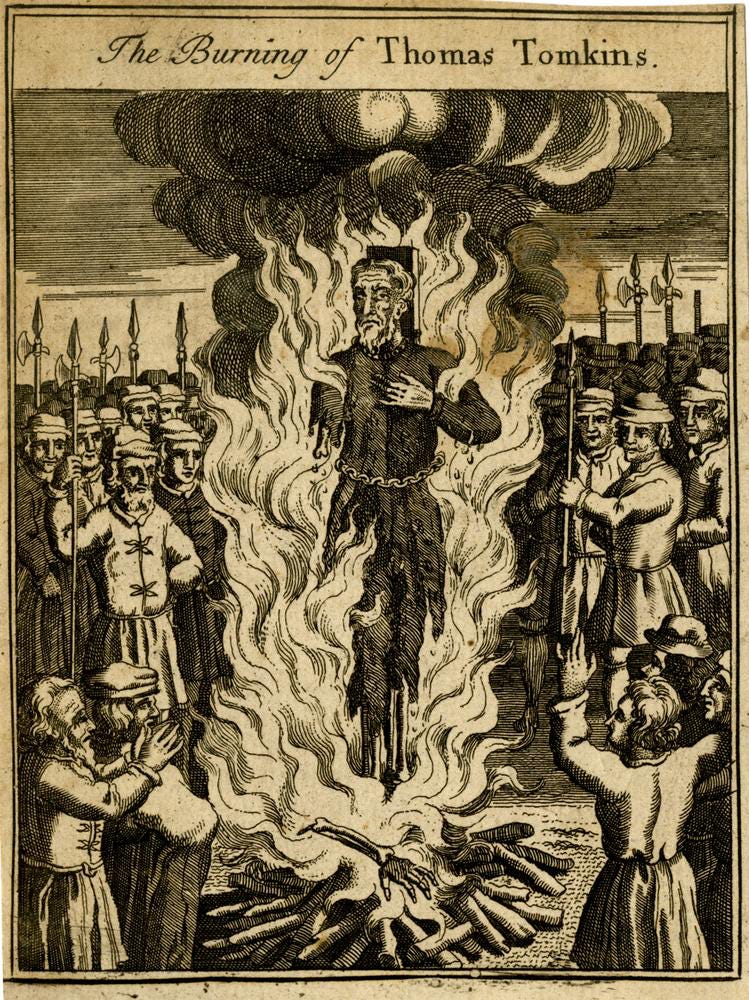Smithfield Martyrs
Burned for Belief: Lessons from Smithfield in a New Age of Censorship
As you walk out of Farringdon tube station towards Smithfield in central London—once home to the famous meat market—you may be forgiven for being unaware of the history beneath your feet. Just a short distance from St Paul’s Cathedral, this area was, for centuries, a site of public executions. Here, not only were animals and cattle butchered, but people too.
One such person was Thomas Tomkins, a simple, devout Christian and a weaver by trade who lived in Shoreditch. He was summoned before the cruel Edmund Bonner, the Bishop of London, alongside five others. They were all treated with great brutality. So intense was Bonner’s rage against Tomkins that he struck him in the face and even tore out part of his beard with his bare hands. But Tomkins, grounded in his faith, refused to be intimidated.
On another occasion, Bonner, holding a lighted taper, held the flame beneath Tomkins’ hand until the veins shrank and the sinews burst. Still, Tomkins remained unmoved.
After half a year in prison, he was brought before Bishop Bonner and his assistants for examination. Presented as evidence was a signed confession, dated the 6th of the month, which read:
"Thomas Tomkins of Shoreditch, and of the diocese of London, hath believed and doth believe, that in the sacrament of the altar, under the forms of bread and wine, there is not the very blood and body of our Saviour Jesus Christ in substance, but only a token and remembrance thereof—the very body and blood of Christ being only in heaven, and nowhere else."
When asked if the statement was his own, Tomkins affirmed that it was, and that it was true.
The following day, he was again brought before Bonner and urged to recant and return to the Roman Church. But Tomkins stood firm. Declared an obstinate and damnable heretic, he was handed over to secular authorities and burned at the stake in Smithfield on March 6th, 1555.
Many others were also burned in those dark years—for adhering to the Scriptures and challenging what they believed to be corruption and deviation within the Church.
So, as you walk past these London landmarks, let us pause and reflect on the great sacrifices made by these martyrs—men and women who gave their lives for the freedom of belief and speech. They challenged error and stood for conscience at great personal cost. These were individuals who counted not their lives dear to themselves, that they might finish their course with joy. They were the champions of their faith, baptised in blood, enlightened beyond their time.
Let us also remember and pray for the brave and heroic today—those who stand against the oppressive regimes of our modern world, regimes that send weapons across the globe to slaughter and massacre innocent men, women, and children. Many of these victims have never threatened or occupied our land but seek only to live freely in their own.
Let us not forget those who now languish in prison under newly imposed, draconian laws that threaten to strip British citizens of their right to speak out against injustice.
As we revisit Smithfield and its history, we are reminded that it took centuries of sacrifice and blood to win even the smallest freedoms in this land. Those who came before us gave everything in the pursuit of truth. How quickly, it seems, that hard-won liberty is being eroded.
Let us honour their memory—and remain vigilant to preserve the freedoms they died to secure.
Source: Foxe, J. (2001). Foxe’s Book of Martyrs (Updated edition). Whitaker House.


